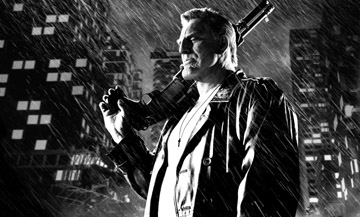Movie Review - Sin City: A Dame to Kill For
By Matthew Huntley
September 2, 2014
BoxOfficeProphets.com

Now comes Sin City: A Dame to Kill For, and just like the first movie, it’s amazing to behold. Directors Robert Rodriguez and Frank Miller have once again crafted a stunning black-and-white world, full of sharp, pulsating contrasts, that’s about as close to a manifestation of Miller’s graphic novels as you can get. And, once again, the only primary colors are red, yellow and green, which underline the film’s brutal, prolific violence and make certain character traits, like hair, eyes and skin, jump off the screen.
But, and here’s the catch, we’ve seen all this before. Because A Dame to Kill For is a sequel, Rodriguez and Miller are faced with the more difficult task of making a movie that doesn’t rely on its cosmetics to hold the audience’s interest. We can still be mesmerized by the images, and we are, but the individual stories and characters have to give us something more than just superficial narration. In other words, A Dame to Kill For needs to give us reasons to watch it instead of simply resorting to the same qualities that made the first “Sin City” so distinct.
And there are reasons, but perhaps not enough. Each of the film’s three stories stands on its own and is interesting and energetic in its own right, and the actors and actresses who fulfill the archetypal film noir roles are easily up to the task of engaging us with their presence and body language, but there’s just something about the film as a whole that makes us feel like we’ve already been down this road. Watching it is like going on a rollercoaster you’ve ridden before: it gives you pleasure and a rush for the simple fact it’s a rollercoaster, but because you already know where the first drop and flip are going to be, it’s ultimately less special. Going into A Dame to Kill For, we don’t know exactly when or how everything is going to happen, but after a while, we can guess and we’re mostly right.
That’s not to say it’s not worth seeing, and not only for its look and design, but also for the way the cast exuberantly sinks their teeth into their respective parts: Mickey Rourke as the chain-smoking, weathered-faced Marv, who’ll still protect women at any cost to himself; Jessica Alba as Nancy, the dancing showgirl wounded by the death of her only love and savior, Detective Hartigan (Bruce Willis), who shot himself in the head at the end of the last movie so as to protect Nancy from the corrupt Senator Roark (Powers Booth); Joseph Gordon-Levitt as Johnny, an over-confident poker player who thinks he can beat the senator fairly and squarely but perhaps bites off more than he can chew; and Josh Brolin as Dwight (played by Clive Owen in the last film), who gets mixed up with ta dangerous and money-hungry vixen named Ava (Eva Green).
These are just some of the players. The all-star cast also features Rosario Dawson, Dennis Haysbert, Ray Liotta, Christopher Meloni, Jeremy Piven and Christopher Lloyd. Each of their characters is specific and memorable enough that you could easily dress up as one of them for Halloween and say to your friends, “I’m [name of actor/character] from Sin City: A Dame to Kill For,” and they’d know who you mean.
Unfortunately, A Dame to Kill For has come after Sin City, and because it’s so similar in style and narration, it’s not as fresh or impactful as its predecessor. It’s not that it’s a lesser film - either one could have served as the inaugural chapter in the series - but its timing yields it extra narrative responsibility that Rodriguez and Miller don’t seem willing to bear. Perhaps they figured that because audiences liked the first one so much, or because enough time had passed, they could just employ the same devices as before and we wouldn’t care. But we do care, and although the filmmaking duo proves yet again they’re smart, creative storytellers, we wish they’d either given us a more original sequel or no sequel at all.